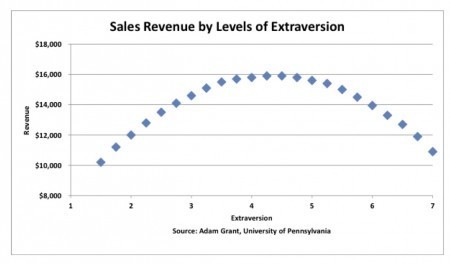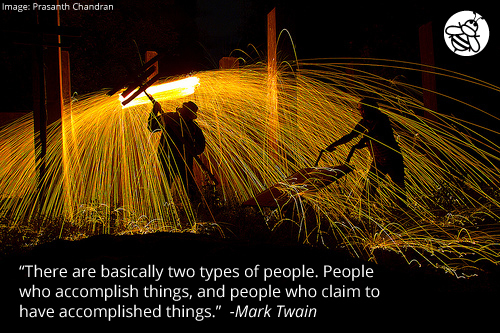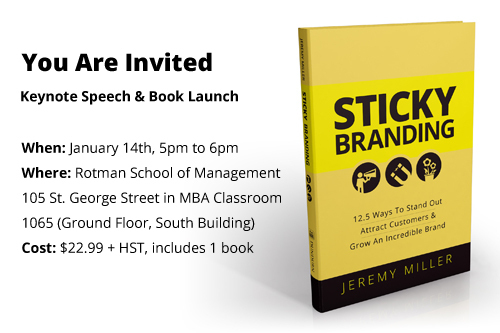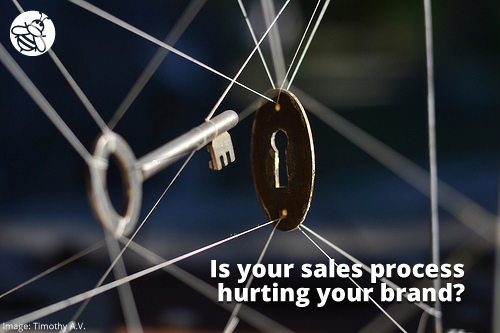Jeremy Miller's Blog, page 42
October 30, 2014
Seller Beware
In the pre-Internet days people used to say, “Buyer Beware.” Companies were in control. They set the price. They educated the buyers. They negotiated from a position of power.
That’s not the case anymore. The tables have turned. It’s “Seller Beware.”
Your customers hold the power. They know as much or more about your products and services as your salespeople. And your customers��are savvy, well-educated buyers with access to an inordinate amount of information.
Like it or not, sales has changed.
Access to information changed everything
The transition from Buyer Beware to Seller Beware happened because of access to information.
The Internet and mobile technologies shifted the power away from companies to customers. The average person is walking around with a computer in their pocket that has access to��high speed internet. Your customers��have all the tools they need to get informed and make smart decisions.
But more importantly, access to information increased consumer confidence.
Buyers are happy to challenge companies. They are happy to ask for more information. And if they’re not satisfied with the buying experience, they know they can easily find another firm that will service their needs.
Customers may not know everything, but they know they can find everything.
Facilitate the buying process
In a Seller Beware marketplace direct sales tactics are ineffective. It’s off putting to feel like you’re being sold.
Train your team to stop selling and start facilitating. You can’t lose a customer when you are helping them make the right decisions.
In many cases your customers know what they want, but they need help making the right decisions. They want to work with experts who can guide them and support them through the buying process. They want to work with companies that make their lives a little bit easier.
Give them that support by facilitating the buying process.
Make the experience memorable
Building a brand in a Seller Beware marketplace is challenging. Not only do you have to serve your customers, you have to leave a positive impression with them.
Break through the clutter by making the buying experience memorable. Find ways to delight your customers by being helpful, interesting, and��truly valuable. Find ways to connect with your customers in a meaningful way so they think of your company first when they have a need.
You can’t stop the Seller Beware marketplace, but you can embrace it.
October 28, 2014
Launching a New Website: What do you think?
In 1999 I bought JeremyMiller.com from Jeremy Miller of Arizona.
I had been tracking this domain through university. Every year I sent the owner an email asking if he was ready to sell the domain yet. Every year he did not reply.
Then one day I got an email, “I’m ready to sell JeremyMiller.com. Are you still interested? If so, how much will you offer for the domain?” I was one of three Jeremy Miller’s cc’d on that email.
I was excited. I wanted this domain. I knew I would use it one day.
I replied to the email immediately with an initial offer of $250. As soon as that had left my computer I called my bank to secure a loan. They were willing to increase my line of credit to $10,000. That was my budget. That’s what I would have spent on that domain.
I sat on pins and needles for a few days filled with self-doubt. Was my bid too low? Did I insult the seller? Did someone else outbid me before I even started? What happened?
A week later I received a reply, “Thanks for the offer Jeremy. I accept.” That was it. I wired him $250, and I got the .com of my name.
Fifteen years later I am finally launching JeremyMiller.com. It’s my new Professional Speaker website.
I love speaking and sharing ideas on branding and business development. It’s one of the most rewarding activities I do. And with the launch of my new book, Sticky Branding, I’m doing a lot more keynotes and workshops.
Let me know what you think: www.JeremyMiller.com. All comments and criticism are welcome.
And if the site strikes a chord and you want to have me speak at your company or event, all the better. I’d love to connect.
I also want to point out the great work of my partners, Paul Sveda and Opal Gamble at Design & Develop. They created this site. I work closely with them on client projects for websites, brand development, and design projects. I do the strategy and content creation, they do the design and development.
October 23, 2014
Content Marketing is a Marathon
Content marketing is a crucial part of your marketing mix, but it’s a marathon.
Week after week you have to come up with new and interesting things to write about. You have to find new angles, new ideas, and new stories. You have to consistently create content that gets people to say, ���That’s interesting. Tell me more.���
And the operative word here is ���consistently.��� Writing one great article is not enough. Content marketing demands you do that month after month, if not day after day.
Set your pace
The blank page is intimidating if you run out of things to say, which is not unusual.
Structure is the savior to the blank page. It’s your pace:
How often will you publish?
How long are your posts?
What is the format of your content?
I publish every Tuesday and Thursday at 5:00 a.m. EST. My articles are between 350 to 500 words, and they have an introduction, two to three sub-headings, and a conclusion.
This is my pace. Instead of worrying about form and format, I can focus on ideas, concepts, and insights that I think will resonate with you and deliver value.
What’s your pace?
Fuel your content
You can’t complete a marathon if you don’t maintain your energy. You need food and water to keep going.
The same is true for content marketing. You need to constantly consume other’s content to consistently produce your own content.
I consume content from three primary sources:
Feedly . I subscribe to a couple hundred blogs and magazines, and read it every morning. It’s like the morning paper, and I get a fresh dose of content and ideas every day.
Podcasts. I listen to podcasts in the car and when I’m doing chores. I gain a ton of ideas from the interviews with experts.
Books. There’s no better source of ideas than reading long form content. It gives me time to digest an idea and expand my thinking.
Consuming content is part of my routine, and gives me the fuel to share new content week after week.
How do you fuel your content marketing?
Have a backup
Inevitably you will hit a bump in the road and something will sideline you: an illness, a major deadline, a family emergency, a vacation, or something else.
Have backup content for these days. I like to keep a content vault, and draw from these articles when life or business gets in the way.
Keep writing
To run a marathon requires running. You’ve got to put one foot in front of the other and just keep going.
This is true for content marketing. Once you commit to a blog or an email newsletter you are going to be doing it for a long time. It’s at least a five year marathon, if not more.
Set your expectations and get typing. There’s a lot of great ideas you have to share.
October 21, 2014
Ideas Are Cheap, Action Is Not
“There are basically two types of people. People who accomplish things, and people who claim to have accomplished things. The first group is less crowded.” -Mark Twain
Companies that are propelled to act will always outperform the dreamers and ideators.
But few are propelled to act. Tom Peters wrote in In Search of Excellence, “Faced with an opportunity to achieve something significant, beyond their routine day-to-day tasks, most managers simply do not grab it.”
Growth doesn’t happen in the sandbox
Companies can lose sight of the need to act as they search for the perfect idea.
Companies think and brainstorm and analyze and search. They talk and talk, looking for that one, perfect idea that will take them to the next level. But as Paul Kerr, CEO of Scalar Decisions, says, “You don’t grow like we do if all you do is sit around in the sandbox and talk about strategies.”
I profiled Scalar for��my upcoming book, Sticky Branding, because they are one of Canada’s fastest growing companies. Within ten years the company has grown to over $140 million in revenue!
Scalar’s approach is action oriented. Paul says, “I love having goals in place, driving towards them, getting them accomplished, and then setting new goals.”
A propensity to act
Larry Bossidy and Ram Charan write in Execution, “I saw that leaders placed too much emphasis on what some call high level strategy, on intellectualizing and philosophizing, and not enough on implementation. People would agree on a project or initiative, and then nothing would come of it.”
Every high growth company I encounter has a propensity for action. They will take an idea or a strategy and they’ll run with it. If it doesn’t work they learn, adapt, and approach it from another angle.
Their attitude is to let the competition get mired in strategic planning and ideation. They treat strategy and execution as one. They plan and execute with fluidity.
Be ruthless with ideas
There’s no shortage of ideas in this world. The challenge is finding the few great ones that are aligned with your company’s purpose and values, and then ruthlessly implementing them.
Does your company have a culture of action?
October 16, 2014
Ask Your Clients For Feedback
Direct customer feedback is an essential ingredient for brand building and delivering outstanding services. Good, bad, or ugly you need to hear how your company is doing. And getting that input is easy. All you have to do is ask for it.
There���s no better way to verify your company���s performance than hearing it directly from your clients.
Make feedback part of your business
At every opportunity, look for ways you can gather feedback from your customers. Merge Solutions, for example, asks their clients for feedback after every project.
���As a project is wrapping up we have a meeting to debrief with the client,��� says Alaric Nurm, VP of Operations of Merge. ���The step is so important. We are communicating with the client throughout a project, but at the end of the process we need to sit down with the client and assess what we did well and what we could have done better.���
Gathering feedback is baked into their business operations. It happens with every client and every project.
Build trust with openness
Good feedback is open and unfettered, but getting that can be easier said than done.
Alaric says, ���Clients don���t necessarily like to deliver negative feedback, at least not right away. We will help kickstart the conversation by being very open. I find clients are more likely to open up when we are proactive in calling out issues in the project without being prompted to do so.���
Trust is a two-way street, and clients often need to see you are serious about receiving their feedback ��� good, bad, or ugly ��� before they will give it.
Embrace the feedback
Collecting the feedback is only one step. What you do with it is what matters.
Alaric says, ���We have an internal mandate where we want all of our clients to be referenceable and give us a testimonial.���
Merge���s approach to gathering feedback is designed to build those sticky customer relationships. The feedback provides them the data and insights they need to continually improve, delight their customers, and generate those much needed referrals.
Gathering client feedback is not complicated or difficult. All it requires is purpose and effort. Take the time to engage your clients in meaningful conversations and they will tell you how your firm is performing and where it can improve.
October 14, 2014
Sticky Branding Book Launch: You Are Invited
In a little less than 3 months my new book will be published: Sticky Branding: 12.5 Principles to Stand Out, Attract Customers & Grow an Incredible Brand.
I would like to invite you to a keynote presentation and book launch on January 14th at the Rotman School of Management. Rotman has engaged me to deliver a talk as part of their “Branding Experts Speaker Series,” and introduce my new book to the world.
The event is from 5pm to 6pm at
Rotman School of Management, University of Toronto
105 St. George Street in MBA Classroom 1065 (Ground Floor, South Building)
Toronto, Ontario
The price of admission is $22.99, and includes a copy of the book.
Seating is limited so register soon: https://www.rotman.utoronto.ca/ProfessionalDevelopment/Events/UpcomingEvents/20150114JeremyMiller.aspx
Sticky Branding Book Synopsis
Sticky Branding is a branding playbook for small- and medium-sized companies.
Sticky Brands exist in almost every industry. Companies like Apple, Nike, and Starbucks have made themselves as recognizable as they are successful. But large companies are not the only ones who can stand out. Any company of any size can grow their company into a Sticky Brand.
Based on a decade of research into what makes companies successful, Sticky��Branding’s 12.5 guiding principles are drawn from hundreds of interviews with CEOs and business owners who have excelled within their industries.
By following their examples your company will:
Attract more customers
Sell more faster
Inspire employee engagement
Become immune to the competition
Earn higher profits
This is your branding playbook. It provides ideas, stories, and exercises to make your company stand out, attract customers, and grow into an incredible brand.
Join me on January 14th
I’m really excited about this book and the initial buzz. The people who have read it have found it practical, action-oriented, and motivational. It is propelling them to grow their companies into Sticky Brands.
Join me on January 14th at Rotman. It’s going to be an amazing event.
October 9, 2014
The Most Powerful Leadership Question
On his podcast, Michael Hyatt shared one of the most powerful leadership questions I have encountered.
While CEO of Thomas Nelson Publishers, Michael came off a particularly challenging month. The company missed its revenue targets and was behind on plan.
Michael’s business coach asked him what happened. Michael gave the tactical reasons why the company had missed its targets: the economy was still in a recession, their industry segment was down, and they failed to meet a product launch. All very reasonable reasons for lower sales results.
His coach then asked, “What was it about your leadership that led to that result?”
Wow! What a stunning question.
The buck stops with you
It doesn’t matter your role or the size of your business, you are accountable for the results.
Michael’s first response to “What happened?” is a natural one. We look to the forces and events that shaped our outcomes. There’s often very discernible behaviors or situations that prevent us from achieving our goals.
But if you are very self-aware, you can see you have influence over those forces. When you do a debrief ask yourself, “What was it about my leadership that led to this result?”
Embrace the question
The question cuts to the core.
In the podcast Michael recounted his response the question, “I felt defensive. I said, ���What are you implying?'” He then deferred responsibility, “It was Ron’s fault. He was leading the sales division, he committed to that number, and he didn’t deliver.”
The coach pressed on, “Ok, I get that. But what was it about your leadership that didn’t enable Ron to accomplish his goal?”
If you are honest with yourself and open to the question you can get to the root of your leadership skills.
How are you going to change?
“What was it about my leadership that led to this result?” opens the door. It kickstarts the conversation, and gets you to dive into your approach and behaviors. But you’re not done yet.
Follow up the question with one more, “What would I have done differently?”
Hindsight is 20/20. We can’t change the past, but we can learn from it. Ask the tough questions:
What was it about my leadership that led to this result?
What would I have done differently?
October 7, 2014
Is Your Sales Process Hurting Your Brand?
A flawed sales process can unravel all the goodwill created by your brand.
I’m acutely aware of this lesson today. I’m ramping up to launch my new book, Sticky Branding, in January and I’m engaging service providers to help me promote the book. On my desk are two proposals for different services with equivalent fees. One is a one page agreement, and the other is 17 pages.
I signed and returned the one-pager the day I received it. The��17-pager,��on the other hand, hasn’t been signed. The firm’s sales process has been overly complex and time-consuming, and we’re 45 days in without a decision.
Your brand and marketing create the conditions for a sale. But a flawed sales process can tear down all that good work.
4 traits of an effective sales process
Your customers do not have the time, nor the interest, to deal with an ineffective sales process. They expect better:
Expertise
Above all else, your customers want to work with experts ��� people who can help them identify and solve their issues. They don’t need a “relationship.” They need someone who knows his stuff, can get to the point, and deliver real value.
Responsive
Respond immediately to every customer request. They don’t want to wait 2, 5, or 10 days for someone to get back to them. They want a response right away.
Anxiety
Your time is precious, and so too is your customers. Create anxiety to make decisions and move forward. There’s no need to muck about with one more call or one more demo. Get to the next step.
Brevity
Does it take longer than 3 minutes to read one of your brochures or proposals? If so, they are too long.
A proposal reinforces what you talked about. The customer doesn’t need to read executive bios, company history, why you are excited to work with them, or how your products are a fit for their business. Get to the point. Reinforce what you will deliver, and provide the terms and conditions.
Look for decision-jams
Is your sales process hurting your brand? To find out, look for decision-jams in the buying cycle:
Are there places your customers are pausing or getting stuck?
Do you receive a lot of rejections or fall-offs at certain points in the sales cycle?
These decision-jams could indicate your sales process is flawed. Find these jams and eliminate them. Make your sales process live up to the expectations your brand is setting.
October 2, 2014
Extraverts Are Not Better at Sales, but Neither Are Introverts
There is a myth in business that extraverts are better salespeople.
For decades companies have assumed that “the talkers” are naturally oriented for selling. Their ability to connect with people, spark up conversations, and engage with other humans gave them a perceived competitive advantage.
The research has proven otherwise. Being highly extraverted is not a predictor of success. Actually, a high degree of extraversion can work against you.
Three degrees of extraversion
This week I had the opportunity to see Dan Pink, author of Drive and To Sell Is Human, speak (he was amazing).
He shared a fascinating insight: ambiverts are better salespeople than both introverts and extraverts.
I never heard the term “ambivert” before, so I did a bit of research. As with everything in life, people are not black and white. Being an introvert or an extravert are at two ends of the spectrum.
The vast majority of people fall somewhere in between: ambiverts. And these are the people who excel in sales.
Ambiverts outperform the extraverts
The research Dan Pink shared came from Adam Grant, a Wharton professor and author of Give and Take.
 Adam conducted a comprehensive study of sales professionals, and found extraverts performed only marginally better than introverts.
Adam conducted a comprehensive study of sales professionals, and found extraverts performed only marginally better than introverts.
In the chart, Adam demonstrates that the more introverted or extraverted a person is the lower their overall sales performance will be.
Adam writes, “Because they naturally engage in a flexible pattern of talking and listening, ambiverts are likely to express sufficient assertiveness and enthusiasm to persuade and close a sale but are more inclined to listen to customers’ interests and less vulnerable to appearing too excited or overconfident.”
It’s a question of balance. Ambiverts can listen and talk, and they adapt better to the needs of their customers.
Assumption leads to hiring mistakes
The concept of ambiverts is new to me, but it brought up a crucial insight.
The world of sales is filled with myths and assumptions. Hiring managers assume extraverts must be better at sales, because they are more outgoing, gregarious, and persuasive. But the data proves otherwise.
It reminds me of the old saying, “When you ASSUME you make an ASS out of YOU and ME.”
Are you an extravert, introvert, or ambivert?
Dan Pink offers a neat free assessment to indicate if you are an extravert, introvert, or ambivert.
http://www.danpink.com/assessment
Take the survey and share your results in the comments. What is your level of extraversion? Were you surprised with the results? If so, why?
September 30, 2014
Pick Up the Phone and Start Dialing
So many business problems can be solved with one simple behavior: pick up the phone and start dialing.
In the Wolf of Wall Street, Jordan Belfort (played by Leonardo DiCaprio) rallies his team with an electrifying speech. He shouts,
So you listen to me and you listen well.
Are you behind on your credit card bills? Good! Pick up the phone and start dialing!
Is your landlord ready to evict you? Good! Pick up the phone and start dialing!
Does your girlfriend think you’re a fucking worthless loser? Good! Pick up the phone and start dialing!
I want you to deal with your problems by becoming rich!
“Pick up the phone and start dialing” isn’t just good advice for sleazy stock brokers pushing penny stocks. It’s good advice for anyone. Confront your problems head on: pick up the phone and start dialing.
The pen doesn’t sell
Early on in my career my sales manager used to say, ���The pen doesn’t sell.���
What he meant is you can’t sell a customer with an email, a brochure, or a proposal. The only way you can sell is by talking with them, understanding their needs, and demonstrating you can solve their problems. The pen simply reinforces what you said.
The pen doesn’t solve problems either:
If you receive a customer complaint, pick up the phone.
If you want to do a survey or find out what your customers think, pick up the phone.
If you’re frustrated with someone on your team, pick up the phone.
It doesn’t matter the situation. Don’t waste time with emails and memos. Pick up the phone. Have a conversation. People solve problems when they work together and speak to each other directly.
Phone Fear is real
People avoid the phone like it’s the plague. They’d rather text, email, tap out morse code on a telegraph, send smoke signals ��� whatever it takes to avoid picking up the phone.
Phone Fear runs rampant in the corporate world. I saw this all the time when I hired recruiters in my previous company. The first thing we did with new hires was put them on the phones. We knew if someone resisted making calls or looked for alternative forms of communication, they wouldn’t be successful in our company.
Phone Fear is very real, but it can be overcome. The hardest part is picking up the phone. Once that step is done, the rest will sort itself out.
Talk to people
Jordan Belfort’s call to action motivates the heck out me, because the advice is so true.
Do you want to generate more sales? Good. Pick up the phone and start dialing.
Do you want to improve customer service? Good. Pick up the phone and start dialing.
Do you want to innovate and solve problems? Good. Pick up the phone and starting dialing.
You’re not going to grow your business by yourself. You need people. You need to talk with them, collaborate with them, and work with them. And the fastest way to get that started is to pick up the phone and start dialing.
Here’s a short clip of Jordan Belfort’s speech (note, the language is quite profane):













